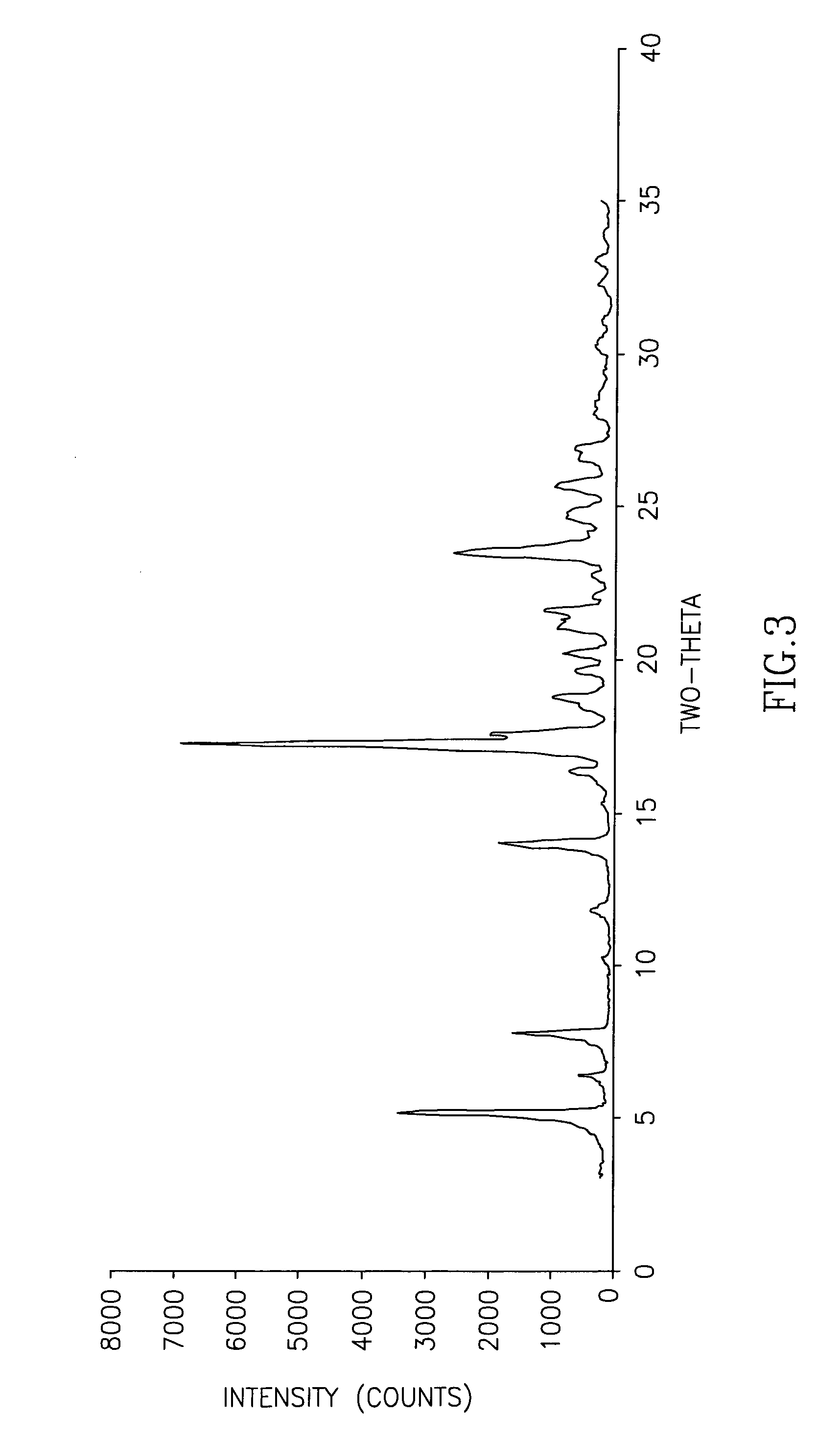Process for producing cisatracurium compounds and associated intermediates
a technology of cisatracurium and intermediates, applied in the field of organic chemistry, can solve the problems of large waste, undesirable hplc purification, formation of decomposition products,
- Summary
- Abstract
- Description
- Claims
- Application Information
AI Technical Summary
Problems solved by technology
Method used
Image
Examples
example 1
[0111]This example describes the preparation of (1R)-1-[(3,4-dimethoxyphenyl)-methyl]-1,2,3,4-tetrahydro-6,7-dimethoxy-2-tert-butoxycarbonylethyl-isoquinoline oxalate.
[0112]
[0113](R)-Tetrahydropaverine hydrochloride (20 g, 0.0527 moles) was dissolved in water (80 ml) and 25% aqueous ammonium hydroxide solution was added to produce a pH in the range of 9-10. Toluene (140 ml) was added and the mixture was stirred for 15 minutes at ambient temperature (about 25° C.). The upper organic layer was separated and washed with 10% sodium chloride solution. The organic layer was dried over magnesium sulfate and, subsequently, concentrated to about 50 ml. Tert-butyl acrylate (9.3 ml, 0.0636 moles) and glacial acetic acid (1.6 ml, 0.0267 moles) were added to the concentrated solution. The resulting mixture was heated to 80° C. and stirred at 80° C. for 5 hours. Subsequently, the mixture was cooled to ambient temperature and a solution of oxalic acid dihydrate (7.4 g, 0.0587 moles) in acetone (35...
example 2
[0116]This example describes the preparation of (1R)-1-[(3,4-dimethoxyphenyl)methyl]-1,2,3,4-tetrahydro-6,7-dimethoxy-2-aminocarbonylethyl-isoquinoline oxalate.
[0117]
[0118](R)-Tetrahydropaverine hydrochloride (30 g, 0.079 moles) was dissolved in water (120 ml) and 25% aqueous ammonium hydroxide solution was added to produce a pH in the range of 9-10. Toluene (200 ml) was added and the mixture was stirred for 15 minutes at ambient temperature. The upper organic layer was separated and washed with 10% sodium chloride solution. The organic layer was dried over magnesium sulfate and, subsequently, concentrated to about 70 ml. Acrylamide (6.72 g, 0.0946 moles) and glacial acetic acid (2.4 ml, 0.04 moles) were added to the concentrated solution. The resulting mixture was heated to 80° C. and stirred at 80° C. for 5 hours. Subsequently, the mixture was cooled to ambient temperature and a solution of oxalic acid dihydrate (11 g, 0.0873 moles) in acetone (50 ml) was added to afford a suspens...
example 3
[0123]This example describes the preparation of (1R)-1-[(3,4-dimethoxyphenyl)methyl]-1,2,3,4-tetrahydro-6,7-dimethoxy-2-methoxycarbonylethyl-isoquinoline oxalate.
[0124]
[0125](R)-Tetrahydropaverine hydrochloride (25 g, 0.0658 moles) was dissolved in water (100 ml) and 25% aqueous ammonium hydroxide solution was added to produce a pH in the range of 9-10. Dichloromethane (100 ml) was added and the mixture was stirred for 15 minutes at about 25° C. The upper organic layer was separated. The procedure was repeated by extracting with dichloromethane (3×100 ml) another 3 times. The combined organic layer was washed with 10% sodium chloride solution. The organic layer was dried over magnesium sulfate and, subsequently, evaporated to dryness under reduced pressure to afford a residual oil. To the residual oil was added benzene (50 ml), methyl acrylate (10 g, 0.1163 moles) and glacial acetic acid (1.3 ml, 0.0217 moles). The mixture was heated at 80° C. for 4 hours. Subsequently, the mixture ...
PUM
| Property | Measurement | Unit |
|---|---|---|
| pH | aaaaa | aaaaa |
| temperature | aaaaa | aaaaa |
| volume | aaaaa | aaaaa |
Abstract
Description
Claims
Application Information
 Login to View More
Login to View More - R&D
- Intellectual Property
- Life Sciences
- Materials
- Tech Scout
- Unparalleled Data Quality
- Higher Quality Content
- 60% Fewer Hallucinations
Browse by: Latest US Patents, China's latest patents, Technical Efficacy Thesaurus, Application Domain, Technology Topic, Popular Technical Reports.
© 2025 PatSnap. All rights reserved.Legal|Privacy policy|Modern Slavery Act Transparency Statement|Sitemap|About US| Contact US: help@patsnap.com



